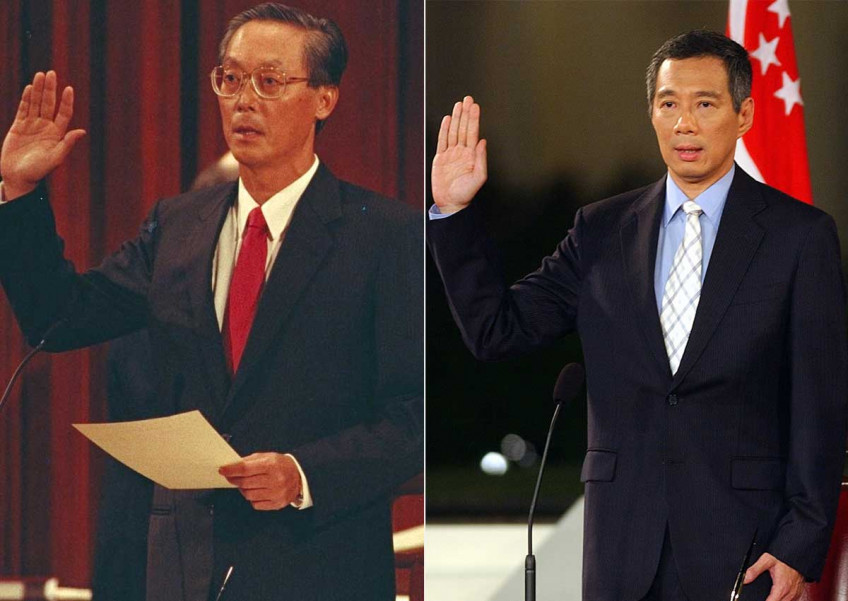How the 2nd and 3rd PMs were chosen

Both prime ministers after Mr Lee Kuan Yew - Mr Goh Chok Tong and current PM Lee Hsien Loong - had long run-ups in politics before they took on the premier's role. Mr Goh had 14 years, while Mr Lee had 20. Their ascension came amid the support of their peers, and the PAP's emphasis on leadership renewal. Insight retraces their routes.
HOW GOH CHOK TONG BECAME PM
Mr Goh was not his predecessor's first choice. The late Mr Lee had felt that Mr Goh had a tendency to try to please everybody, and could be awkward when addressing a crowd. But he refrained from naming a successor, citing the need for the next generation to choose their own man.
Besides, in his peers' eyes, Mr Goh was the man for the job. They had already decided this in 1984, and reaffirmed their choice in 1988, despite Mr Lee making his analysis of Mr Goh public in his National Day Rally speech that year.
The Prime Minister had ranked five younger Cabinet ministers - Mr Goh, Dr Tony Tan Keng Yam, Mr Ong Teng Cheong, Mr S. Dhanabalan and Mr Lim Chee Onn - according to their leadership potential. He revealed that he preferred Dr Tan, then the finance minister, but the latter did not want the job.
Regardless, the next generation had already made its decision after the 1984 General Election, when support for the People's Action Party (PAP) plunged more than 10 percentage points to 64.8 per cent - at the time, the lowest percentage since 1963, when Singapore was a state of Malaysia.
In the seat of Anson, the party lost again to the Workers' Party's J.B. Jeyaretnam, who retained it with a bigger majority. Potong Pasir went to Singapore Democratic Party leader Chiam See Tong.
It was a setback. Some among the party's second-generation leaders were not sure if leadership renewal should go on as planned.
But Dr Tan felt strongly that it had to, or risk Singaporeans losing confidence in the PAP. So on Dec 30, less than a week after the results were announced, he had key second-generation leaders go to his Bukit Timah house.
There, they chose Mr Goh as the first deputy prime minister - essentially the man to succeed Mr Lee when the time came. Mr Ong would be second deputy prime minister.
On Jan 1, 1985, Mr Goh held a press conference at the Istana to unveil the new Cabinet line-up. He likened his position to that of a centre-forward and striker - a dominant role in running the country's affairs - and that of Mr Lee, who was still the prime minister, to a goalkeeper.
Over the next five years, Mr Goh's team was tasked with the day-to-day running of the state even though the official handover took place only in November 1990.
Even then, it was not until 1992 that Mr Lee gave up the position of PAP's secretary-general to Mr Goh.
LEE HSIEN LOONG'S RISE TO PM
When current Prime Minister Lee Hsien Loong entered politics in 1984, many Singaporeans assumed he might one day become prime minister. This belief was bolstered by Mr Goh's selection of the younger Lee to be his second-in-command over Mr Ong when he assumed the top post in 1990.
Mr Goh later said he had canvassed the views of his team, and added that it would not reflect well on the PAP's self-renewal drive if he picked someone older than he.
"That might mean I was protecting my position," he said. Mr Lee is 11 years younger than him, while Mr Ong was five years older.
But in 1992, Mr Goh was hit by the double whammy of both his deputy prime ministers getting cancer. Both later recovered.
Adhering to the PAP's principle of self-renewal, he continued to bring in MPs of high calibre, including newcomer Teo Chee Hean in a by-election in his own Marine Parade GRC a month later. Today, Mr Teo is Acting Prime Minister whenever Mr Lee is away.
In his 2003 National Day Rally speech, Mr Goh announced that Mr Lee would take over as prime minister. "The clear consensus is Hsien Loong. He is also my choice," he said then. Mr Lee was sworn in as prime minister a year later.
One difference between the two men's transitions was Mr Lee's swift assumption of the role of PAP chief. Just four months after he became prime minister, he was elected secretary-general at a party conference.
CHOOSING THE NEXT LEADER
What about Prime Minister No. 4? Similar to how Prime Ministers No. 2 and No. 3 were chosen, Mr Lee Hsien Loong said in 2007 - just three years after he took the top post - and he would not anoint his successor but leave the decision to the next generation.
Like his father, he believed the leadership had to gel, and that could happen only if the leader were to emerge naturally from the group who supported him.
He said: "Ultimately, it's really the PAP MPs who must have confidence in him because, constitutionally, the prime minister is the person who commands the confidence of the majority of the MPs in Parliament."

This article was first published on Sept 4, 2016.
Get a copy of The Straits Times or go to straitstimes.com for more stories.